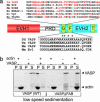The bundling activity of vasodilator-stimulated phosphoprotein is required for filopodium formation
- PMID: 16675552
- PMCID: PMC1457090
- DOI: 10.1073/pnas.0511243103
The bundling activity of vasodilator-stimulated phosphoprotein is required for filopodium formation
Abstract
Filopodia are highly dynamic finger-like cell protrusions filled with parallel bundles of actin filaments. Previously we have shown that Diaphanous-related formin dDia2 is involved in the formation of filopodia. Another key player for the formation of filopodia across many species is vasodilator-stimulated phosphoprotein (VASP). It has been proposed that the essential role of VASP for formation of filopodia is its competition with capping proteins for filament barbed-end interaction. To better understand the function of VASP in filopodium formation, we analyzed the in vitro and in vivo properties of Dictyostelium VASP (DdVASP) and extended our findings to human VASP. Recombinant VASP from both species nucleated and bundled actin filaments, but did not compete with capping proteins or block depolymerization from barbed ends. Together with the finding that DdVASP binds to the FH2 domain of dDia2, these data indicate that the crucial role of VASP in filopodium formation is different from uncapping of actin filaments. To identify the activity of DdVASP required in this process, rescue experiments of DdVASP-null cells with mutant DdVASP constructs were performed. Only WT DdVASP, but not a mutant lacking the F-actin bundling activity, could rescue the ability of these cells to form WT-like filopodia. Our data suggest that DdVASP is complexed with dDia2 in filopodial tips and support formin-mediated filament elongation by bundling nascent actin filaments.
Conflict of interest statement
Conflict of interest statement: No conflicts declared.
Figures







Similar articles
-
Clustering of VASP actively drives processive, WH2 domain-mediated actin filament elongation.EMBO J. 2008 Nov 19;27(22):2943-54. doi: 10.1038/emboj.2008.211. Epub 2008 Oct 16. EMBO J. 2008. PMID: 18923426 Free PMC article.
-
Formins and VASPs may co-operate in the formation of filopodia.Biochem Soc Trans. 2005 Dec;33(Pt 6):1256-9. doi: 10.1042/BST0331256. Biochem Soc Trans. 2005. PMID: 16246092 Review.
-
Requirement of a vasodilator-stimulated phosphoprotein family member for cell adhesion, the formation of filopodia, and chemotaxis in dictyostelium.J Biol Chem. 2002 Dec 20;277(51):49877-87. doi: 10.1074/jbc.M209107200. Epub 2002 Oct 17. J Biol Chem. 2002. PMID: 12388544
-
The Diaphanous-related formin dDia2 is required for the formation and maintenance of filopodia.Nat Cell Biol. 2005 Jun;7(6):619-25. doi: 10.1038/ncb1266. Epub 2005 May 22. Nat Cell Biol. 2005. PMID: 15908944
-
Filopodia and their links with membrane traffic and cell adhesion.Semin Cell Dev Biol. 2020 Jun;102:81-89. doi: 10.1016/j.semcdb.2019.11.017. Epub 2019 Dec 13. Semin Cell Dev Biol. 2020. PMID: 31843255 Review.
Cited by
-
Actin dynamics associated with focal adhesions.Int J Cell Biol. 2012;2012:941292. doi: 10.1155/2012/941292. Epub 2012 Mar 8. Int J Cell Biol. 2012. PMID: 22505938 Free PMC article.
-
Virulent Burkholderia species mimic host actin polymerases to drive actin-based motility.Cell. 2015 Apr 9;161(2):348-60. doi: 10.1016/j.cell.2015.02.044. Cell. 2015. PMID: 25860613 Free PMC article.
-
Clustering of VASP actively drives processive, WH2 domain-mediated actin filament elongation.EMBO J. 2008 Nov 19;27(22):2943-54. doi: 10.1038/emboj.2008.211. Epub 2008 Oct 16. EMBO J. 2008. PMID: 18923426 Free PMC article.
-
Differential VASP phosphorylation controls remodeling of the actin cytoskeleton.J Cell Sci. 2009 Nov 1;122(Pt 21):3954-65. doi: 10.1242/jcs.044537. Epub 2009 Oct 13. J Cell Sci. 2009. PMID: 19825941 Free PMC article.
-
Ena orchestrates remodelling within the actin cytoskeleton to drive robust Drosophila macrophage chemotaxis.J Cell Sci. 2019 Feb 18;132(5):jcs224618. doi: 10.1242/jcs.224618. J Cell Sci. 2019. PMID: 30718364 Free PMC article.
References
-
- Zigmond S. H. Curr. Opin. Cell Biol. 2004;16:99–105. - PubMed
-
- Watanabe N., Kato T., Fujita A., Ishizaki T., Narumiya S. Nat. Cell Biol. 1999;1:136–143. - PubMed
-
- Evangelista M., Pruyne D., Amberg D. C., Boone C., Bretscher A. Nat. Cell Biol. 2002;4:260–269. - PubMed
-
- Peng J., Wallar B. J., Flanders A., Swiatek P. J., Alberts A. S. Curr. Biol. 2003;13:534–545. - PubMed
-
- Pellegrin S., Mellor H. Curr. Biol. 2005;15:129–133. - PubMed
Publication types
MeSH terms
Substances
Associated data
- Actions
LinkOut - more resources
Full Text Sources
Other Literature Sources
Molecular Biology Databases

